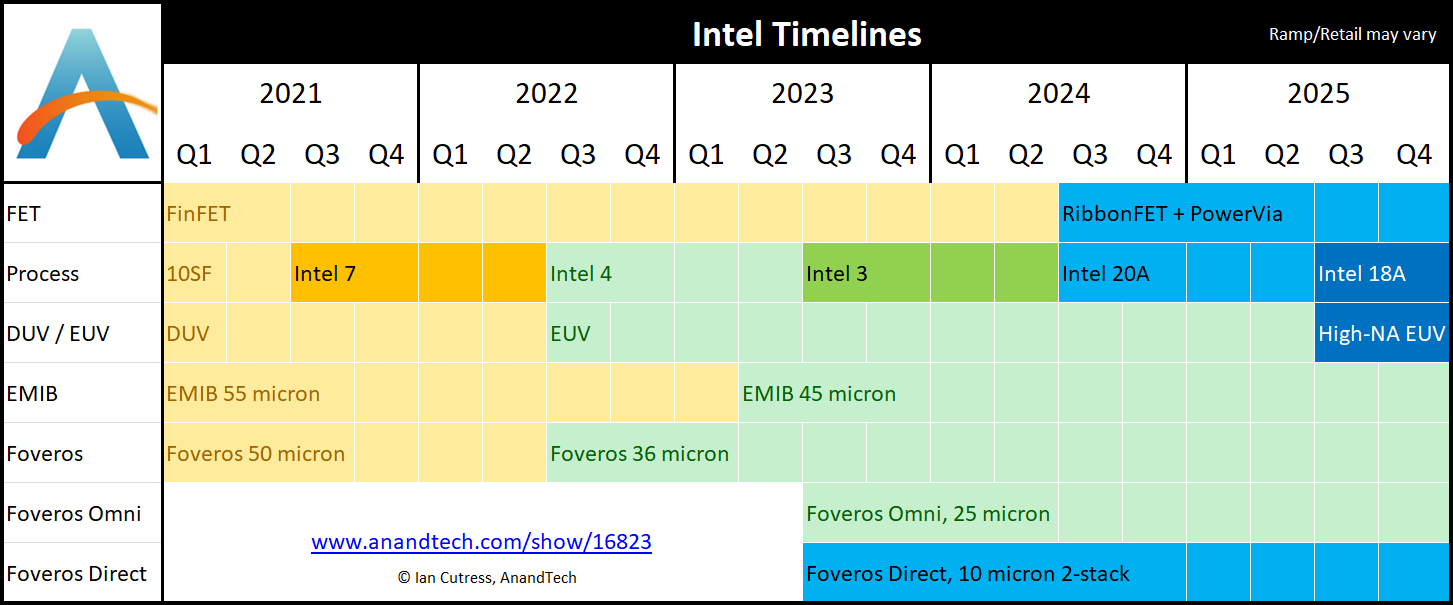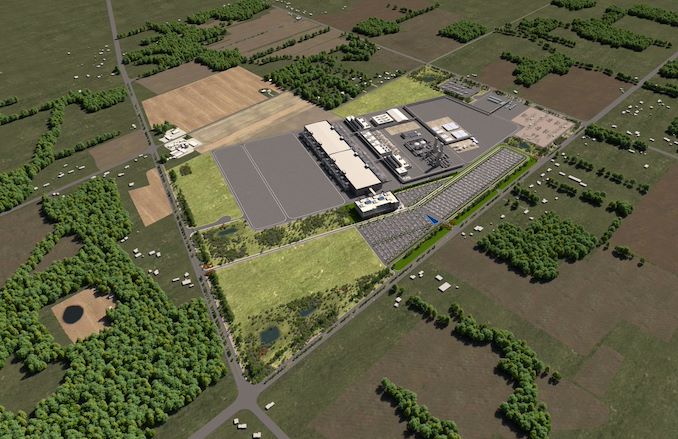Intel Announces Ohio Fab Complex: 2 New Fabs For $20B, And Space For More
by Ryan Smith on January 21, 2022 1:00 PM EST
With fab expansions on tap across the entire semiconductor industry, Intel today is laying out their own plans for significantly increasing their production capacity by announcing their intention to build a new $20 billion fab complex in Ohio. With the paperwork already inked and construction set to begin in late 2022, Intel will be building two new leading-edge fabs in their new Ohio location to support future chip needs. And should further demand call for it, the Ohio complex has space to house several more fabs.
Intel’s announcement follows ongoing concerns about chip fab capacity and national security, as like other chip fabs, Intel is looking to expand their capacity in future years amidst the current chip crunch. All the while, the United States government has become increasingly mindful about how much chip production takes place in geopolitically tricky Taiwan, placing additional pressure on firms to build additional fabs within the US. To that end, Intel has been not-so-secretly undertaking a search to find a good location for a new fab campus, and they have finally found their answer in Ohio.
The new site, Intel’s first new manufacturing site location in 40 years, is located in New Albany, Ohio, just outside of Columbus. Up until now, all of Intel’s major chip fab sites have been in the western United States – Oregon, Arizona, and at one point, Silicon Valley – so the Ohio site is a significant move for the company. All told, the Ohio “mega-site”, as Intel likes to call it, covers nearly 1000 acres. And while Intel is only initially planning for two fabs, the site offers plenty of room to grow, offering enough space for a total of 8 fabs.
The immediate goal of the company – and the crux of today’s announcement – revolves around the building of two new leading-edge fabs at the Ohio location. According to Intel, these two fabs will begin construction late this year, with production coming online in 2025. The company isn’t formally stating what the initial process node will be – instead saying that it will be using the "industry's most advanced transistor technologies" – however if the company is indeed building truly bleeding-edge fabs, then 2025 lines up with Intel’s 18A process, which will be 4 generations newer than what Intel is using now (Intel 7).
Altogether, Intel expects the project to cost about $20 billion, which is similar to what Intel will be spending for its two new Arizona fabs, which were announced just under a year ago. And further down the line, should Intel opt to fill the rest of the property with the other 6 fabs that the site can support, the company expects that the total price tag could reach nearly $100 billion. Ultimately, the company is making it clear that they are priming the site not just to met their mid-term production needs with the initial two fabs, but are making sure to have the space ready for further capacity expansion over the long-term.
As to whether Intel eventually builds those further 6 fabs, that will depend on a few factors. Key among these will be demand from Intel Foundry Services clients; while Intel will be using some of the Ohio site’s capacity for their own needs, the site will also be used to fab chips for IFS customers. If Intel’s bid to break into the contract fab business is successful, and the company is able to woo over additional clients/orders, then they will need to build additional fabs to meet that demand.
Also hanging in the balance is what the US Government opts for, both in terms of orders and incentives. The Ohio fabs will be used for domestic production of sensitive chips, as the US looks to secure its supply lines. Meanwhile the CHIPS for America Act and its 53 billion in incentives will also be a. Intel for its part isn’t playing coy about its interest in the CHIPS money, explicitly stating that “The scope and pace of Intel’s expansion in Ohio, however, will depend heavily on funding from the CHIPS Act”. In some respects Intel is taking a bit of a gamble by investing in the Ohio location before any CHIPS funding is approved – on a pure cost basis, overseas production is traditionally cheaper – so there is certainly a political element in announcing these fabs and selecting an Ohio location. And as an added incentive to the US Government, Pat Gelsinger has told Time that Intel would even be interested in bringing some chip packaging, assembly, and testing back to the US if the CHIPS Act were funded, which in turn would allow Intel to do every last step of production within the US.
But more immediately, Intel’s focus is on getting its first two Ohio fabs up and running. Along with building the facilities they’ll need a workforce to operate them, and as a result the company is also pledging $100M over a decade in funding for local educational efforts. As with similar local industry efforts, that investment would be focused on helping local colleges and universities establish semiconductor manufacturing curricula to help train the technical workforce required.
And while outside of Intel’s own investment scope, the creation of their Ohio fab complex means that Intel’s suppliers are also coming along for the ride. According to the company, Air Products, Applied Materials, LAM Research and Ultra Clean Technology have all indicated that they’ll be setting up facilities in the area. All of which the company is using to further underscore the size of the project and the value it brings to the area – and why they deserve that CHIPS Act funding.
Ultimately, the addition of a third US fab site and two more fabs to Intel’s portfolio is the latest step Intel has taken under Pat Gelsinger’s IDM 2.0 strategy. Gelsinger opted to go all-in on having Intel fab chips for themselves and others, and this is the kind of expansion that Gelsinger has been alluding to as necessary to make IDM 2.0 a reality. Taken altogether, Intel now has 4 leading-edge fabs set to come online in the 2024-2025 timeframe, and with any luck on Intel’s part, there will be room for several more to come.
Source: Intel












112 Comments
View All Comments
mode_13h - Monday, January 24, 2022 - link
> we need to balance the Federal Budget.No, but the long-term trend of the budget deficit should be bent downward to grow slower than inflation. That's not just about spending. It's also about revenue (i.e. taxation).
ChrisGX - Saturday, January 22, 2022 - link
Intel could do well in the foundry business but I don't see that as fundamental to Intel's microprocessor business -- complementary yes, fundamental no.And, how are Intel's mainstream and specialised microprocessor businesses faring? Not so well, if IC Insights data is right. In 2021, a year in which growth rates for semiconductor companies (in the USA and elsewhere) were typically high -- above 20% for the sector as a whole -- Intel experienced a slight decline in revenues.
TheinsanegamerN - Saturday, January 22, 2022 - link
Really hared to make the "their foundries were not fundamental" when said foundries were critical to their processors cutting edge performance for the better part of 30 years, and allowed them to literally print money providing for the server and consumer markets. Even when on the uncompetitive 14nm+++ node they couldnt keep up with orders, and TSMC is utterly floored unable to keep up with demand resulting in a planetwide "chip shortage"And you're going to argue that intel foundries are not fundamental to their success? Really?
ChrisGX - Saturday, January 22, 2022 - link
Intel's foundry operations are complimentary, but not fundamental, to its microprocessor business. I think that is a proposition supported by Intel's behaviour. If its foundry operations were truly fundamental to its microprocessor business then presumably shopping around for other foundries to fabricate Intel processors would be a no-no, but that is exactly what Intel has recently done signing contracts with TSMC for a significant number of 3nm parts.Perhaps, you are missing the point. Launching into a large commercial foundry business may work out well for Intel but it won't likely lift the performance of its microprocessor business. At the moment the weight of evidence suggests that Intel is finding it harder and harder to demonstrate any significant technological advantages for its own processors over rival products from AMD, Apple or a number of on the rise manufacturers building (infrastructure or consumer) SoCs based on licensed ARM tech. Intel's loss of leadership in microarchitecture is not a problem that will be resolved by raising the profile of its foundry business.
kwohlt - Saturday, January 22, 2022 - link
The point being missed is that TSMC has a tremendous amount of money they can invest in R&D because they make so many chips. With each node shrink, the cost continues to rise substantially to the point that Intel being the only "customer" of their own fab is not enough to support future R&D efforts.The semi-conductor industry shifts around. Intel no longer being the current leader in perf/watt does not signify some permanent shift from which they'll never recover. I see them already signing on Amazon and Qualcomm as customers of their GAA process, expecting to beat TSMC to market with this design. I see them being the first fab to acquire High-NA EUV machines from ASML. I see TSMC having delays with their N3 process. I see Intel building a massive, expensive fab in Ohio. The only conclusion that comes to my mind is that there will be a highly competitive fab industry by 2025.
x86 will continue to be around for a long time - and bringing up ARM doesn't seem to be the "got ya" you think it is. x86 doesn't have to break into the smart phone market if one of the largest ARM designers (Qualcomm) chooses to manufacture at Intel Foundries.
ChrisGX - Sunday, January 23, 2022 - link
Not having its own foundry facilities didn't stop AMD experiencing year on year annual growth in revenues of 65% in 2021 or similar rapid growth by MediaTek (60%), Nvidia (57%) or Qualcomm (51%) in the same period. Having its own foundry facilities didn't stop Intel suffering a decline in revenues of 1% during a year in which the semiconductor sector as a whole grew by 23%.Now, obviously, in-house foundry operations aren't fundamental to fast growing chip manufacturers like AMD, MediaTek, Nvidia or Qualcomm because, as a matter of fact, fabless chip manufacturers like those just mentioned are very successfully making their way in the world entirely free of such operations. It is easy to insist that Intel's foundry operations are somehow essential or fundamental to Intel as a microprocessor manufacturer but the evidence of the great success of fast growing fabless semiconductor designers/manufacturers/vendors belies that lazy line of thinking. Intel, like other chip manufacturers before it could easily spin off its foundry operations without Intel's chip business losing a beat. Given the scale of Intel's chip business, though, it has reason enough to retain its foundry operations. The integrated device manufacturing model can support product optimization, improve economics, and ensure supply resilience. But, the pure play foundry services model also has its attractions. TSMC, as you point out, has a tremendous amount of money that it can invest in R&D and given the nature of TSMC's business it constantly intensifies investments to improve the state of the art of silicon fabrication and to offer to its foundry partners (at a price) new technological options for 3D silicon stacking and advanced packaging. That, of course, is pretty much what fabless chip manufacturers want from a contract manufacturer.
The way the semiconductor industry has evolved has meant that chip design and chip fabrication are being pursued more and more as discrete activities. Would AMD, MediaTek, Nvidia or Qualcomm benefit from some integrated device manufacturing capability that they currently lack? Not obviously. Those companies are fast growing chip designers/suppliers whereas Intel with its IDM capability is stagnant.
I am not sure what to make of Pat Gelsinger's promotion of IDM 2.0 (it just sounds like cheerleading to me) and it isn't apparent to me why this would be the right fit for fabless semiconductor manufacturers. I suspect that Intel is just generating a noisy narrative that serves it purposes in the current situation. But, perhaps there is a simpler account for Intel's recent manoeuvring. It is evident that global foundry capacity needs to grow a lot and Intel arguably just wants to get a piece of that pie or, perhaps, needs a piece of that pie given the moribund condition of its chip business. Also, given the current nervousness about national/local manufacturing and the favourable mood in government circles (in the US and elsewhere) towards extending aid to corporations in order to bolster key national industries, Intel may be just opportunistically raising its hand in the hope to become a recipient of a hefty share of that governmental largesse.
https://www.icinsights.com/data/articles/documents...
https://publicseminar.org/essays/semiconductor-chi...
Mike Bruzzone - Tuesday, January 25, 2022 - link
Intel SF10 currently has a 25 cents on the dollar cost advantage over AMD and Nvidia when applying the foundry mark up, otherwise Intel and TSMC production costs are similar. Intel strategy is to trail on the downward sloping cost curve of every last node while AMD and Nvidia get hit with the factor cost increase on every next node; note the classic Intel watcher, learner, fast follower. AMD has to maintain at least 1.5 nodes ahead of Intel on cost add of foundry mark up or AMD losses performance for area advantage that has already occurred for V5x 7 nm v AL SF10/7. Subsequently Rembrandt 6 and Genoa 5 has been shipping since q3 2021. Sapphire Rapids is also shipping. Genoa and SR in risk volumes to hyperscale / cloud (HPC) because no one waits at the leading edge. mbwhatthe123 - Wednesday, January 26, 2022 - link
you're comparing growth of companies like AMD who had almost no market 5 years ago, to the growth of intel who has been twiddling their thumbs with greater than 90% x86 market ownership until recently. AMD benefits both from the market's growth and intel's loss of performance dominance, whereas intel is limited by its ability to supply chips and has only recently put in TSMC orders for chips that will go into their CPUs.If anything, the fact that AMD has a clearly dominant design for the past 2~3 years yet is still severely supply constrained and gradually regaining marketshare shows you just how much of a gap there is in volume between the two companies. Hardly comparable at all.
Mike Bruzzone - Wednesday, January 26, 2022 - link
whatthe123, yes AMD is supply constrained. AMD broke 100 M units this year for the first time ever approximately 111,954,324 units I'll be able to confirm that when q4 10Q comes out. All up AMD has produced 326,491,986 Zen based components since Summit introduction in February 2017. Intel capacity before fab initiatives is 400 M units annual + 100 M outsourced to foundries. I can also confirm AMD has to keep 1.5 nodes ahead to maintain its area advantage on large cache applications performance strategy and 1) process is saturating and 2) nodes will stack as in like a train car crash and 3) Intel has placed that TSMC 3 nm road block. mb, former Cyrix, NexGen, AMD, ARM, IDT Centaurmode_13h - Thursday, January 27, 2022 - link
> AMD has to keep 1.5 nodes ahead to maintain its area advantage> on large cache applications performance strategy
Did it occur to you that as AMD grows, it has more resources to invest in design & other new tech? So, maybe that lead on design that Intel seems to have is now dropping to 1 node, and maybe it'll drop to 0.5 nodes by the time Zen 5 hits.